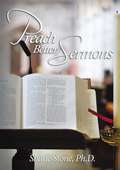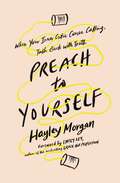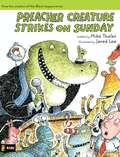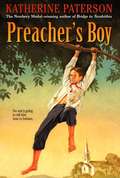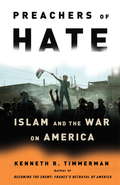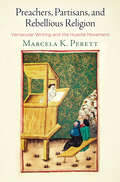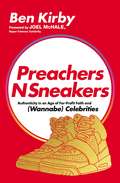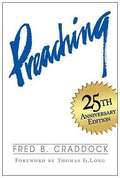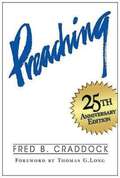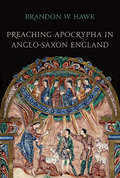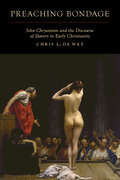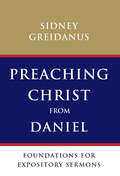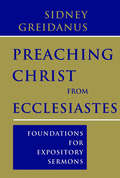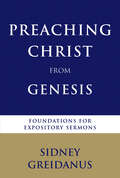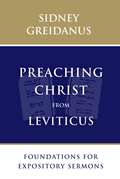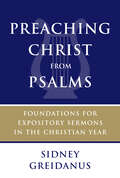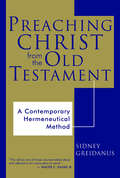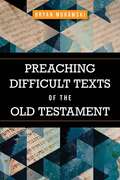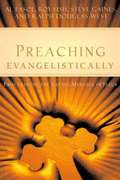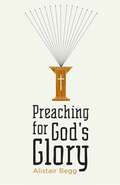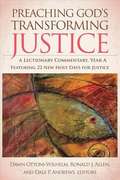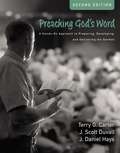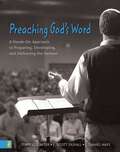- Table View
- List View
Pre-Modernity, Totalitarianism and the Non-Banality of Evil: A Comparison of Germany, Spain, Sweden and France
by Steven SaxonbergThis book provides a comparative and historical analysis of totalitarianism and considers why Spain became totalitarian during its inquisition but not France; and why Germany became totalitarian during the previous century, but not Sweden. The author pushes the concept of totalitarianism back into the pre-modern period and challenges Hannah Arendt’s notion of the banality of evil. Instead, he presents an alternative framework that can explain why some states become totalitarian and why they induce people to commit evil acts.
Preach Better Sermons
by Shane StoneThe objective of this book is to address the following premises: <P><P>Premise number one: The purpose and aim of Christian preaching/teaching is to produce spiritually faithful, biblically capable, and productively active disciples of Jesus Christ. <P><P>Premise number two: Conventional preaching/teaching philosophies and methods are not achieving the desired effects in far too many cases. This is evidenced by the numbers of lukewarm churches and spiritually broad-but-not-deep Christians. <P><P>Premise number three: A paradigm shift in how sermons and Bible lessons should be prepared and communicated will help alleviate the problem and is long overdue. <P><P>This book addresses the shortcomings of modern Christian preaching, envisions the strongest and deepest approaches to biblical teaching and learning, and lays out specific steps to get churches’ classrooms and pulpit ministries from where they are to where they need to be.
Preach to Yourself: When Your Inner Critic Comes Calling, Talk Back with Truth
by Hayley Morgan Emily LeyBreak the cycle of doubting yourself, take God at His word, and talk back with truth - a new message of freedom from bestselling coauthor of Wild and Free Hayley Morgan.We know Christ came to speak life, but then how come our inner critic keeps showing up and stealing the mic? If we’re honest, she’s a harsh one, saying things we’d never dream of saying to others: You’ll never measure up, you’ll fail again tomorrow, you just can’t get it right. It has been said that the eighteen inches from head to heart is the soul’s longest journey. Our head knows the good news is true, but our heart struggles to believe it, and it is in this gap that we battle to believe the promises of God.Hayley Morgan, coauthor of bestselling book Wild and Free, has wrestled with this tension her whole life. In Preach to Yourself, she tackles it head-on to discover how we can renew our minds to renew our lives. For every woman who struggles with repetitive, negative self-talk, this book will show you how to identify the toxic loops where you get stuck and replace them with the truth of God we can believe with our whole selves.This is not a “try harder” reprimand, it’s a “believe better” invitation: to take God at His word when He tells you who you are. Come along and learn a simple practice to break free from the lies holding you back, and step forward into the fullness of life God has planned.
Preacher Creature Strikes on Sunday
by Mike ThalerWith hilarious stories and nutty pictures, the Tales from the Back Pew series offers kid’s a unique view of church. Enjoy plenty of giggles with your child—and learn fun, important truths about God, church, and the Bible. Mom is taking me to church this Sunday. I’ve heard a lot about church. You have to stand up, sit down, and kneel a hundred times. It’s called being in the service—I’m too young to be drafted!
Preacher's Boy
by Katherine PatersonIn 1899, ten-year-old Robbie, son of a preacher in a small Vermont town, gets himself into all kinds of trouble when he decides to give up being Christian in order to make the most of his life before the end of the world.
Preachers Dare: Speaking for God
by Bishop William H. WillimonPreachers Dare is adapted from Will Willimon’s Lyman Beecher Lectures on Preaching at Yale and is inspired by a quote from the great theologian Karl Barth. In a world in which sermons too often become hackneyed conventional wisdom or tame common sense, preachers dare to speak about the God who speaks to us as Jesus Christ. Willimon draws upon his decades of preaching, as well as his many books on the practice of homiletics, to present a bold theology of preaching. This work emphasizes preaching as a distinctively theological endeavor that begins with and is enabled by God. God speaks, preachers dare to speak the speech of God, and the church dares to listen. By moving from the biblical text to the contemporary context, preachers dare to speak up for God so that God might speak today. With fresh biblical insights, creativity and pointed humor, Willimon gives today’s preachers and congregations encouragement to speak with the God who has so graciously and effusively spoken to us.
Preachers of Hate: Islam and the War on America
by Kenneth R. TimmermanAnti-semitism among Muslims has outrun the number of Jews in the world, and now threatens Americans in particular and all Westerners in general, says investigative journalist Timmerman. He spouts such notions as Arafat's reign of terror and the Islamic Republic of America. Annotation ©2004 Book News, Inc. , Portland, OR (booknews. com)
Preachers, Partisans, and Rebellious Religion: Vernacular Writing and the Hussite Movement (The Middle Ages Series)
by Marcela K. PerettIn early fifteenth-century Prague, disagreements about religion came to be shouted in the streets and taught to the laity in the vernacular, giving rise to a new kind of public engagement that would persist into the early modern era and beyond. The reforming followers of Jan Hus brought theological learning to the people through a variety of genres, including songs, poems, tractates, letters, manifestos, and sermons. At the same time, university masters provided the laity with an education that enabled them to discuss contentious issues and arrive at their own conclusions, emphasizing that they held the freedom to make up their own minds about important theological issues. This marketplace of competing religious ideas in the vernacular emerged in Bohemia a full hundred years before the Reformation.In Preachers, Partisans, and Rebellious Religion, Marcela K. Perett examines the early phases of the so-called Hussite revolution, between 1412, when Jan Hus first radicalized his followers, and 1436, the year of the agreement at the Council of Basel granting papal permission for the ritual practice of the Utraquist, or moderate Hussite, faction to continue. These were years during which the leaders of competing reform movements needed to garner the laity's support and employed the vernacular for that purpose, translating and simplifying basic theological arguments about the Bible, the church's ritual practice, and authority in the church. Perett illustrates that the vernacular discourse, even if it revolved around the same topics, was nothing like the Latin debates on the issues, often appealing to emotion rather than doctrinal positions. In the end, as Preachers, Partisans, and Rebellious Religion demonstrates, the process of vernacularization increased rather than decreased religious factionalism and radicalism as agreement about theological issues became impossible.
PreachersNSneakers: Authenticity in an Age of For-Profit Faith and (Wannabe) Celebrities
by Ben KirbyFounder of the phenomenon social media account PreachersNSneakers tackles how faith, capitalism, consumerism, and (wannabe) celebrity have collided.What started as a joke account on Instagram has turned into a movement. Through this provocative project, the founder of PreachersNSneakers is helping thousands of Jesus followers wrestle with the inevitable dilemmas created by a culture obsessed with image and entertainment.In PreachersNSneakers: Authenticity in an Age of For-Profit Faith and (Wannabe) Celebrities, the author boldly confronts many of the difficult questions plaguing countless Christians&’ minds, such as:Should pastors grow wealthy off of religion, and why do we get so angry when they do?Is it okay to stoke envy among others with curated &“lifestyle&” images on social media?Do we really believe that divine blessings are monetary, or is that just religious wallpaper to hide our own greed?Is there space in Christendom for celebrities like Kanye and Bieber to exist without distorting the good news?What about this: Is it wrong for someone like this author to call out faith leaders online and leverage &“cancel culture&” to affect change?PreachersNSneakers will navigate these challenging questions and many more with humor, wit, candor, and a few never-before-published hijinks. Each chapter will explore the various sides of the debate, holding space for readers to make up their own minds. The book will doubtlessly become a staple for church small groups, college ministries, and book clubs, emboldening struggling believers who want to live a more genuine faith.After all, the Lord works in mysterious colorways.
Preaching
by Fred B. CraddockThe appearance of this 25th anniversary edition of Fred B. Craddock's highly original and influential textbook on preaching is a cause for celebration, not only of the book itself but also of Fred Craddock, the preacher and teacher. While Preaching, as a textbook, has its own integrity and takes a justifiably proud place in the literature of homiletics, it is almost impossible for many of us to read this volume without hearing Craddock's unmistakable and delightful voice and oral style crackling through its pages. This volume is not like some textbooks-- say, in physics or calculus--that bear no evidence of their authors personalities or convictions. In this book, there is a distinct human voice. It is as if the master preacher Fred Craddock has leaned back in a rocker on the front porch of his Georgia mountain cabin and decided to Stalk preaching for a spell. The result is not only a substantial introduction to the topic but also an enchanting glimpse into the mind and character of one of the most innovative preachers of our time.
Preaching 34579: Revised Edition (Interpretation Ser.)
by Fred B. CraddockA standard textbook on the art and craft of preaching. Craddock weaves history, theology, and hermeneutics into an exhaustive text on sermon preparation and preaching. Painstakingly prepared for seminary students and clergy, this book answers the fundamental question: How does one prepare and deliver a sermon? Craddock's approach is practical, but also allows for concentrated study of any particular dimension of the process."Filled with practical wisdom. . . . A liberating book."--Richard Lischer, Duke University.
Preaching Apocrypha in Anglo-Saxon England (Toronto Anglo-Saxon Series)
by Brandon HawkPreaching Apocrypha in Anglo-Saxon England is the first in-depth study of Christian apocrypha focusing specifically on the use of extra-biblical narratives in Old English sermons. The work contributes to our understanding of both the prevalence and importance of apocrypha in vernacular preaching, by assessing various preaching texts from Continental and Anglo-Saxon Latin homiliaries, as well as vernacular collections like the Vercelli Book, the Blickling Book, Ælfric’s Catholic Homilies, and other manuscripts from the tenth through twelfth centuries. Vernacular sermons were part of a media ecology that included Old English poetry, legal documents, liturgical materials, and visual arts. Situating Old English preaching within this network establishes the range of contexts, purposes, and uses of apocrypha for diverse groups in Anglo-Saxon society: cloistered religious, secular clergy, and laity, including both men and women. Apocryphal narratives did not merely survive on the margins of culture, but thrived at the heart of mainstream Anglo-Saxon Christianity.
Preaching Bondage: John Chrysostom and the Discourse of Slavery in Early Christianity
by Chris L. de WetPreaching Bondage introduces and investigates the novel concept of doulology, the discourse of slavery, in the homilies of John Chrysostom, the late fourth-century priest and bishop. Chris L. de Wet examines the dynamics of enslavement in Chrysostom’s theology, virtue ethics, and biblical interpretation and shows that human bondage as a metaphorical and theological construct had a profound effect on the lives of institutional slaves. The highly corporeal and gendered discourse associated with slavery was necessarily central in Chrysostom’s discussions of the household, property, education, discipline, and sexuality. De Wet explores the impact of doulology in these contexts and disseminates the results in a new and highly anticipated language, bringing to light the more pervasive fissures between ancient Roman slaveholding and early Christianity. The corpus of Chrysostom’s public addresses provides much of the literary evidence for slavery in the fourth century, and De Wet’s convincing analysis is a groundbreaking contribution to studies of the social world in late antiquity.
Preaching Christ from Daniel: Foundations for Expository Sermons
by Sydney GreidanusIn Preaching Christ from Daniel Sidney Greidanus shows preachers and teachers how to prepare expository messages from the six narratives and four visions in the book of Daniel. Using the most up-to-date biblical scholarship, Greidanus addresses foundational issues such as the date of composition, the author(s) and original audience of the book, its overall message and goal, and various ways of preaching Christ from Daniel. Throughout his book Greidanus puts front and center God's sovereignty, providence, and coming kingdom. Each chapter contains building blocks for constructing expository sermons and lessons, including useful information on the context, themes, and goals of each literary unitlinks between Daniel and the New Testamenthow to formulate the sermon theme and goalcontemporary applicationand much more!
Preaching Christ from Ecclesiastes: Foundations for Expository Sermons
by Sidney GreidanusAs Sidney Greidanus points out, the biblical book of Ecclesiastes is especially relevant for our contemporary culture because it confronts such secular enticements as materialism, hedonism, cut-throat competition, and self-sufficiency. But how can preachers best convey the ancient Teacher's message to congregations today? A respected expert in both hermeneutics and homiletics, Greidanus does preachers a great service here by providing the foundations for a series of expository sermons on Ecclesiastes. He walks students and preachers through the steps from text to sermon for all of the book's fifteen major literary units, explores various ways to move from Ecclesiastes to Jesus Christ in the New Testament, and offers insightful expositions that help the preacher in sermon production but omit the theoretical and often impractical discussions in many commentaries.
Preaching Christ from Genesis: Foundations for Expository Sermons
by Sidney GreidanusSidney Greidanus's previous two preaching books -- The Modern Preacher and the Ancient Text andPreaching Christ from the Old Testament -- have received wide acclaim. Preaching Christ from Genesis offers more of Greidanus's solid, practical homiletical fare. Packed with unique features, Preaching Christ from Genesisuses the latest scholarly research to analyze twenty-three Genesis narrativespresents the rhetorical structures and other literary features of each narrativediscloses the message for Israel (theme) as well as the author's likely purpose (goal)explores various ways of preaching Christ from each narrativeoffers sermon exposition and commentary in oral stylesuggests relevant sermon forms, introductions, and applications Including helpful appendixes -- "Ten Steps from Text to Sermon," "An Expository Sermon Model," and three of the author's own Genesis sermons -- this volume will be an invaluable resource for preachers and Bible teachers.
Preaching Christ from Leviticus: Foundations for Expository Sermons
by Sidney GreidanusFor pastors who take seriously the commitment to incorporate the entire Bible into their preaching, Sidney Greidanus&’s books on preaching Christ from the major genres of the Old Testament have been a welcome gift. In his last such volume, Greidanus engages with the Old Testament genre of law and treats a book that is often seen as the most challenging of all: Leviticus. Preaching Christ from Leviticus reminds pastors and congregations that key christological themes—priesthood, sacrifice, atonement, holiness—first originated in Leviticus before they came to full flower in the New Testament with the atoning sacrifice of Jesus Christ and his call to holiness. Greidanus provides the basis for fully understanding these and other themes with an exacting analysis of Leviticus and then provides the foundations for ten sermons on Leviticus through topics such as the burnt offering, the ordained priesthood, the day of atonement, the sabbatical year, and the year of jubilee, as well as the commandments to be holy, to love your neighbor, and to love aliens and enemies.
Preaching Christ from Psalms: Foundations for Expository Sermons in the Christian Year
by Sidney GreidanusIn this penultimate volume of his series on preaching Christ from the Old Testament, Sidney Greidanus offers expert guidance for busy pastors on preaching Christ from Psalms. Beginning with a general introduction on how pastors can interpret and preach from the biblical psalms — and why they should — Greidanus proceeds by discussing twenty-two psalms in the Revised Common Lectionary, Year A, supplying the building blocks necessary to preach from Psalms at Christmas, Easter, Pentecost, and other major days and seasons of the church year. In addition to laying out basic homiletical-theological approaches suitable for each selected psalm, these chapters also provide verse-by-verse exposition, bridges to Christ in the New Testament, and ideas for placing the psalmist&’s words into contemporary context.
Preaching Christ from the Old Testament: A Contemporary Hermeneutical Method
by Sidney GreidanusArguing for the need both to preach Christ in every sermon and to preach regularly from the Old Testament, Sidney Greidanus develops a christocentric method that will help preachers do both simultaneously. Greidanus challenges Old Testament scholars to broaden their focus and to understand the Old Testament not only in its own historical context but also in the context of the New Testament. Suggesting specific steps and providing concrete examples, this volume provides a practical guide for preaching Christ from the Old Testament.
Preaching Difficult Texts Of The Old Testament
by Bryan MurawskiPractical, homiletical advice for preachers on some of the most challenging genres of Scripture What should a preacher do when facing a genealogy while preaching the book of Genesis? How should one handle the geographically rich chapters of Joshua? What about all those laborious architectural details on the tabernacle in Exodus? From the theologically complex to the well-worn narrative, from the long pericopes to the tiniest archaeological details, this book seeks to give honest, practical advice that will better equip preachers to tackle such topics. Each chapter includes an introduction of the difficult passages, definition and examples of the difficult passages, function/purpose of the difficult passages, and how to preach the difficult passages. Chapter topics include: Preaching the Genealogies Preaching the Law Preaching the Lists and Construction Details Preaching the Violent Texts and Imprecations Preaching the Sexually Explicit Texts Preaching the Geography Preaching Intertextuality and Complex Language Issues Preaching the Well-Worn Stories Preaching Theologically Complex or Controversial Passages Preaching Long Pericopes
Preaching Evangelistically: Proclaiming the Saving Message of Jesus
by Al Fasol Roy Fish Steve Gaines Ralph Douglas WestThe purpose of our book is to provide information on preaching evangelistically with integrity with biblical accuracy, with appeal to contemporary listeners, and absolutely for the glory of God.
Preaching For God's Glory
by Alistair BeggSeasoned pastor Alistair Begg observes that much of what is said from today’s pulpits cannot be counted as Bible based, God glorifying, and life changing. Rather than preparing a steady diet of spiritual meat, pastors are mistakenly serving up a self-focused snack―ultimately leaving congregations malnourished and ill prepared to stand firm when their faith is challenged. Recognizing the need for a return to biblical preaching, Begg has written this practical book, outlining the nature of power-filled, expository preaching and demonstrating its importance in the life of the church.
Preaching God's Transforming Justice
by Ronald J. Allen Dale P. Andrews Dawn Ottoni-WilhelmThis unique commentary is the first to help the preacher identify and reflect theologically and ethically on the social implications of the biblical readings in the Revised Common Lectionary. In addition to providing commentary for each day in the lectionary calendar, this series introduces twenty-two Holy Days for Justice. These days are intended to enlarge the church's awareness of God's call for justice and of the many ways that call comes to the church and world today. The days include Martin Luther King Jr. Day, Earth Day, World AIDS Day, International Women's Day, Cesar Chavez Day, Yom HaShoah, and Juneteenth. For each of the lectionary days and Holy Days for Justice there is an essay that helps the preacher integrate a variety of social justice concerns (including racial/ethnic issues, sexism, classism, ecology, and violence) into their preaching. The contributors are a diverse group of homileticians, pastors, biblical scholars, theologians, and social activists.
Preaching God's Word, Second Edition: A Hands-On Approach to Preparing, Developing, and Delivering the Sermon
by J. Daniel Hays J. Scott Duvall Terry G. CarterPeople in churches today are hungry for a word from God. Preachers need to prepare and deliver sound biblical sermons that connect with their audience in a meaningful way. Whether you are a student who is new to preaching or a veteran looking to brush up your preaching skills, you will benefit from Preaching God's Word.Good preaching begins with good exegesis. The second edition of Preaching God's Word is a user-friendly, practical, and proven textbook that walks you through the five steps of the "Interpretive Journey" from the biblical text to contemporary application:Grasp the text in their town (what it meant to the original audience).Measure the width of the river that separates the biblical context from today.Cross the principle bridge by identifying the timeless theological principles.Consult the biblical map.Grasp the text in our town.While the science of solid biblical interpretation is essential to effective preaching, it must be married to the art of contemporary communication in order to bring the message home. Preaching God's Word also shows you how to understand your audience, develop powerful applications, use illustrations well, and deliver the sermon effectively. The concluding chapters discuss the unique preaching challenges presented by the various biblical genres, providing interpretive keys, things to avoid, and numerous examples.
Preaching God's Word: A Hands-On Approach to Preparing, Developing, and Delivering the Sermon
by Terry G. CarterPeople in churches today are hungry for a word from God. Preachers need to prepare and deliver sound biblical sermons that connect with their audience in a meaningful way. Whether you are a student new to preaching or a veteran looking to brush up your preaching skills, here is a valuable resource. Good preaching begins with good exegesis. Preaching God’s Word walks you through the steps of the “Interpretive Journey” from the biblical text to contemporary application: • Grasp the text in “Their Town” (what it meant to the original audience). • Measure the width of the river that separates the biblical context from today. • Cross the “Principalizing Bridge” by identifying the timeless theological principles. • Grasp the text in “Our Town.” While the science of solid biblical interpretation is essential to effective preaching, it must be married to the art of contemporary communication in order to bring the message home. Preaching God’s Word also shows you how to understand your audience, develop powerful applications, use illustrations well, and deliver the sermon effectively. The concluding chapters discuss the unique preaching challenges presented by the various biblical genres, providing interpretive keys, things to avoid, and numerous examples. “Carter, Duvall, and Hays have given us a basic and worthy manual of how-to’s for preaching. Now since Haddon Robinson’s classic text has a book taken such a practical and understandable, step-by-step approach to the sermon.” -Calvin Miller, Professor of Divinity, Beeson Divinity School “In a day when the church-world is lulled into complacency by sermons that are little more than entertaining homilies on good values and fix-it paradigms, here is a guide to proclamation the way it was meant to be…biblical, understandable, and transforming.” -Joseph M. Stowell, Teaching Pastor, Harvest Bible Church; Former President, Moody Bible Institute.

